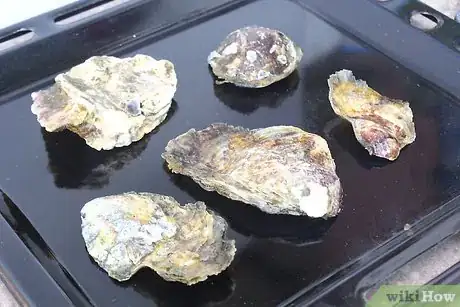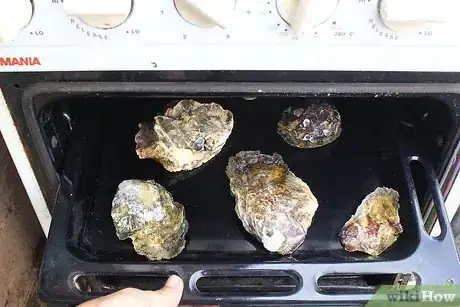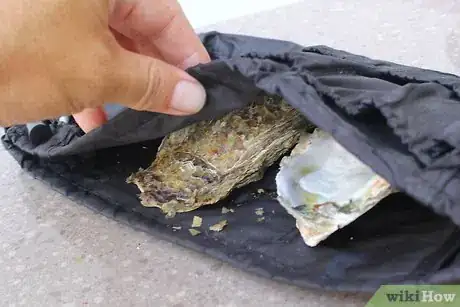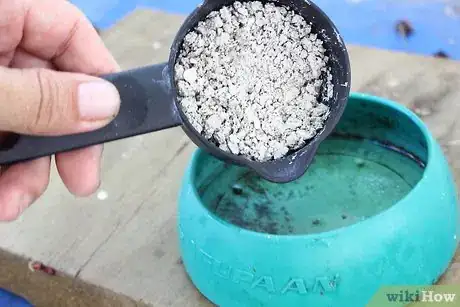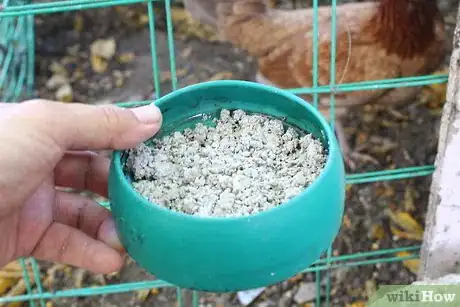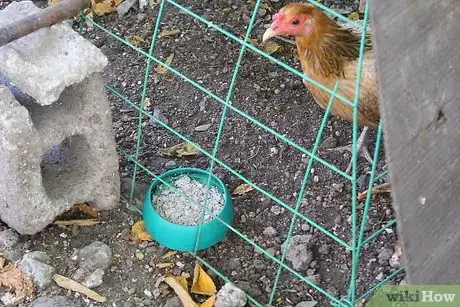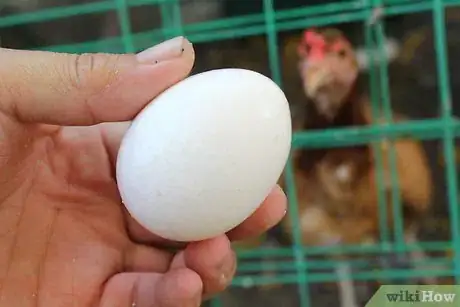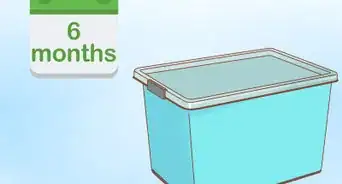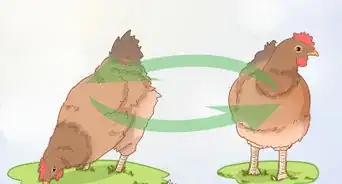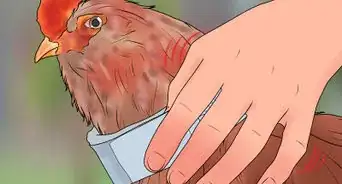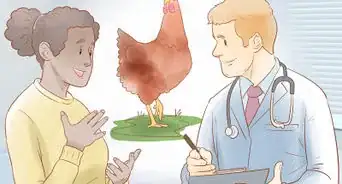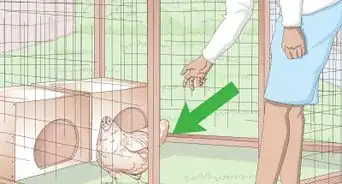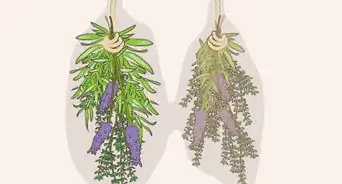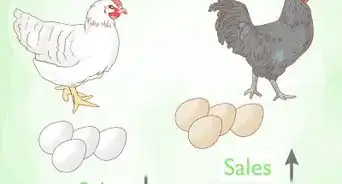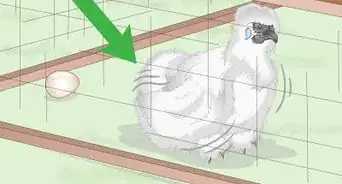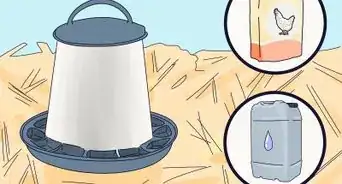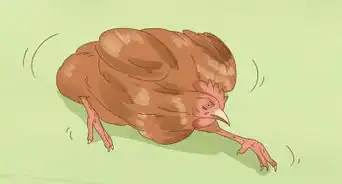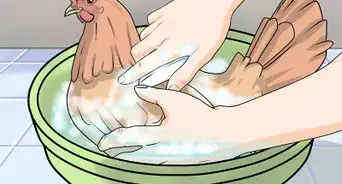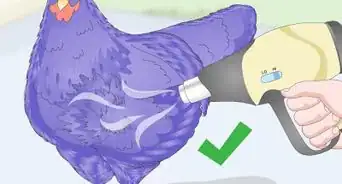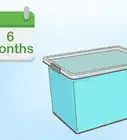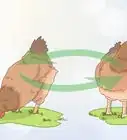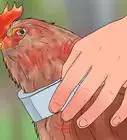This article was co-authored by wikiHow Staff. Our trained team of editors and researchers validate articles for accuracy and comprehensiveness. wikiHow's Content Management Team carefully monitors the work from our editorial staff to ensure that each article is backed by trusted research and meets our high quality standards.
There are 7 references cited in this article, which can be found at the bottom of the page.
This article has been viewed 49,019 times.
Learn more...
Oyster shells are a common calcium source for egg-laying hens. Ground shells are available at most feed stores. Alternatively, you can break down fresh shells with a blunt object or a food processor, then bake them to kill any bacteria. Provide a separate feed bowl full of oyster shells at all times so that your chickens stay healthy throughout the year. Then, wait for your chickens to lay quality eggs!
Steps
Breaking down the Shells
-
1Purchase oyster shells. Feed stores sell bags of oyster shells for a relatively small price. These shells are often pre-ground, saving you a lot of work. Both whole and ground shells can be obtained from a number of locations, including grocery stores. Ordering online is always an option.[1]
- Ground up shells and those at feed stores are typically cooked before you buy them. At grocery stores and some restaurants, they are often raw.
- You may be able to get used oyster shells from restaurants. Introduce yourself to owners by saying, “Hi, I live nearby and I could use your oyster shells for my chickens. Could we work out a deal?”
-
2Bake raw oyster shells at 250 °F (121 °C) for 10 minutes. Place the shells on a baking sheet. If you run out of room, crack the shells into smaller pieces by striking them with a hammer. Once the shells are arranged, preheat the oven to 250 °F (121 °C) and let the shells bake for 10 minutes.[2]
- Baking kills off any mold or bacteria lingering on the shells. While raw shells often don’t cause harm to the chickens, it is better to be safe than sorry.
- Baking also dries out the shells, making them easier to crack.
Advertisement -
3Stuff the oyster shells into a bag. You should break up the oyster shells first so the chickens have an easier time eating them. Start by loading all of the shells into an old sack, pillowcase, or feed bag. These are all safe ways to hold the shells as you strike them with a hammer. Tie the sack shut to protect yourself from flying fragments.[3]
-
4Smash the shells with a hammer. Bring the sack to a spot that won’t be damaged by hammering, such as the ground outside. Lay the sack flat, then strike it with a hammer or another blunt object. Break the shells down until the fragments are the size of your fingernails. Although the size doesn’t particularly matter, smaller shells are easier for a chicken to pick up with its beak.[4]
- You can also drive over the bag with a car to crush the shells quickly.
-
5Use a food processor if you want to grind the shells into a powder. Plug in an old food processor or blender. Dump all of the shell fragments into it, then turn on the machine to finish breaking them down. Your chickens will have no problems gobbling down the powder, which can be fed to them in a number of ways.
- You don’t have to make powder if you don’t want to. Chickens will eat fragments or even whole shells. However, chickens have to peck at the shells to break them if they are too big to swallow.
Feeding the Chickens
-
1Start feeding oyster shells to hens at 18 weeks of age. Oyster shells, along with other calcium boosters, are only meant for egg-laying hens. Once the hens are 18 weeks old, start purchasing oyster shells. Set the shells out in an accessible location. Within a few weeks, the hens should start laying healthy eggs.[5]
- There is no risk of chickens eating too much calcium. If they don’t need it, they won’t eat it. As long as you don’t add it to the food or water, it won’t be an issue.
- Feeding hens younger than 18 weeks can lead to kidney damage. They only need the calcium boost when they lay eggs.
-
2Set the shells out in a feed container inside the coop. Never add the shells to the feed. Instead, set a dish inside the coop or barn. Fill the bowl full of shell powder or fragments. Your chickens will instinctively eat from the bowl when they need the extra calcium. Roosters and younger chickens will avoid it.[6]
- A rabbit feeder is another way to keep the shells available. Install it on a wall where the chickens gather.
- You could also sprinkle some powder on the coop floor or near some plants or grit they peck. They will discover it on their own, but you may find it difficult to monitor how much of it they eat.
-
3Provide oyster shells year-round. Even if you don’t get eggs from your chickens during part of the year, stock the bowl or feeder. Hens still benefit from the calcium. It keeps their bones strong and prepares them to lay more eggs later in the year. If they need it, they will go and eat some.[7]
-
4Give your hens more oyster shells if their eggs break easily. The most recognizable sign of calcium deficiency is thin-shelled eggs. If you notice splattered eggs in the coop or if the eggs break in your hands, calcium deficiency may be the reason. Set out more shells as needed. Make sure they are broken down and placed where the chickens can find them.[8]
- Rough spots and wrinkles on the shell are another sign of low calcium. Your chicken’s eggs should look like they belong in a supermarket.
- Commercial-grade feed does contain calcium. Usually this is enough, but not always. Foraging or table-scrap-fed chickens often need the extra calcium source.
Community Q&A
-
QuestionWhen collecting shells at the beach, I inadvertently got sand that contained small broken glass fragments. The chickens ate this and have stopped laying. Could this have injured them?
 Community AnswerIt most likely injured him. Depending on how severe it is, I suggest you take it to the vet and check it out.
Community AnswerIt most likely injured him. Depending on how severe it is, I suggest you take it to the vet and check it out. -
QuestionHow old will a chicken be when it stops laying eggs?
 Makayla MilesCommunity AnswerThis depends on the breed. Buff Orpingtons, Ameracunas and Rocks can lay well into their 3rd and 4th years. On the other hand, more exotic birds have shorter laying spans.
Makayla MilesCommunity AnswerThis depends on the breed. Buff Orpingtons, Ameracunas and Rocks can lay well into their 3rd and 4th years. On the other hand, more exotic birds have shorter laying spans. -
QuestionIs shell grit from a beach okay for chickens?
 Community AnswerNo because there are other things in it, mostly salt. Instead, just go buy a cheap bag. You can usually find them at Tractor Supply Co. or online at MyPetChicken.com.
Community AnswerNo because there are other things in it, mostly salt. Instead, just go buy a cheap bag. You can usually find them at Tractor Supply Co. or online at MyPetChicken.com.
Warnings
- Avoid feeding calcium to roosters and young chickens. This causes fatal damage to their kidneys.⧼thumbs_response⧽
Things You’ll Need
- Oyster shells
- Sack
- Car, hammer, or other smashing object
- Small feeder bowl
References
- ↑ https://hencam.com/henblog/2011/12/oyster-shell-for-hens/
- ↑ http://www.sialis.org/calcium.htm
- ↑ https://www.youtube.com/watch?v=hJ8gLErQgWo&feature=youtu.be&t=70
- ↑ https://youtu.be/hJ8gLErQgWo?t=99
- ↑ https://www.gov.mb.ca/agriculture/livestock/production/poultry/poultry-rations-and-feeding-methods.html
- ↑ https://countrysidenetwork.com/daily/poultry/feed-health/grit-for-chickens-digestive-health-when-in-doubt-put-it-out/
- ↑ https://countrysidenetwork.com/daily/poultry/feed-health/grit-for-chickens-digestive-health-when-in-doubt-put-it-out/
- ↑ http://blog.mcmurrayhatchery.com/2011/03/29/should-i-feed-my-chickens-oyster-shells/
- ↑ http://www.sialis.org/calcium.htm
About This Article
If you own a chicken, especially one that lays thin-shelled eggs that break easily, you can improve its calcium intake by feeding it oyster shells. First, buy a bag of oyster shells from a feed store, then bake them at 250°F for 10 minutes to kill off any bacteria. Next, stuff the shells into an old sack, pillowcase, or feed bag and use a hammer to smash them into bite-size pieces no larger than your fingernail. Finally, fill a feed container with the crushed shells and place it in your coop for the egg-laying hens to eat. For more tips, like how to grind oyster shells into a powder for your chickens to eat, read on!
